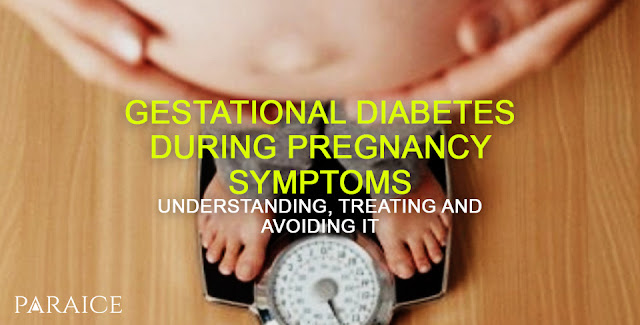Gestational diabetes is diabetes that occurs during pregnancy in 6% of pregnant women. Its frequency would tend to increase.
- Gestational diabetes: risk factors
- Symptoms of gestational diabetes
- Risks of gestational diabetes
- Treatment of gestational diabetes
- Screening for gestational diabetes
- Gestational diabetes: what happens next?
A woman with a blood glucose level of 0.9 g/liter is considered to have gestational diabetes.
Sometimes this is diabetes that was present before pregnancy, but had never been detected.
Gestational diabetes: risk factors
There are several factors that increase the risk of developing gestational diabetes
- Be of Hispanic, Caribbean, African-American or Southeast Asian origin.
- Be more than 30 years old.
- Mother's birth weight less than 2.5 kg.
- Have a family history of diabetes.
- Have a history of glucose intolerance.
- Previous pregnancy history of: gestational diabetes, hypertension, urinary tract infections, excess amniotic fluid.
- Have had a baby weighing more than 4 kg at birth.
- Being obese or overweight.
Symptoms of gestational diabetes
This is the major concern of gestational diabetes: in most cases, the pregnant woman does not experience any symptoms.
Quite rarely, one may notice unusual fatigue, intense thirst or too frequent urges to urinate (difficult to consider this as a symptom in pregnant women!).
Risks for gestational diabetes
When a mother has too much sugar in her blood, she passes it on to her baby, who may become abnormally fat. Fat will be stored in the skin and organs, especially the heart.
Childbirth can be difficult... and in women who have not been able to stabilize their diabetes, a caesarean section is often performed.
Risks for the mother
- Urinary tract infection.
- Hypertension and swelling (preeclampsia).
- Premature delivery.
- Caesarean delivery (if the baby's weight is too great).
- Having type 2 diabetes after pregnancy.
Risks to the baby
- Weight exceeding 4 kg at birth (macrosomia). Concerns nearly 25% of babies born to mothers with gestational diabetes.
- Neonatal hypoglycemia.
- Very severe jaundice in the newborn.
- Respiratory distress syndrome.
- Having type 2 diabetes.
 | |
| Sign up now and get our 28-Day Meal Plan and 10 expert guides to educate and inspire you... |
Treatment of gestational diabetes
Diabetes, whether insulin-dependent or not, must be balanced.
The main solution is a change in diet or lifestyle. This is usually enough to keep blood glucose levels at a normal level.
The mother-to-be will need to :
- Monitor her carbohydrate intake
- Eat fewer foods high in saturated fat (butter, cream, etc.).
- Do not gain too much weight during pregnancy
- Increase your physical activity by exercising regularly.
- Sometimes take insulin (a small injection in the stomach, thigh or arm) under medical supervision (and under a doctor's prescription)
The women concerned are generally cared for by a team of caregivers: doctor, nurse, midwife, dietician.
Screening for gestational diabetes
Different tests can be used to detect abnormally high blood glucose levels.
- O' Sullivan test
- Ingestion of 50 grams of glucose.
- 1 hour later, dosage
- Blood glucose, test result
- Less than 1.3 grams/liter: Test negative
- Contains between 1.3 and 2 grams per liter: Positive test
- Oral glucose tolerance testing (OGTT) is required to confirm diabetes.
- Equal or superior to 2 grams per liter
- Proven gestational diabetes
Diagnosis of Oral Induced Hyperglycemia: OGPO
If the result of the O'Sullivan test leaves any doubt, an HGPO is performed.
Pregnant women ingest 100 g of glucose and then their blood glucose levels are measured every hour for 3 hours.
Pathological thresholds :
- H0 > 0.95 g/l
- H1 > 1.85 g/l
- H2 > 1.55 g/l
- H3 > 1.45 g/l
- Two venous blood glucose measurements at or above these thresholds are a sign of gestational diabetes.- One venous blood glucose measurement at or above these thresholds is a sign of glucose intolerance.
The WHO test is recent. After taking 75 grams of glucose, the venous blood glucose level is measured 2 hours later: If more than 1.4 g/l is obtained, gestational diabetes is proven.
Gestational diabetes: what happens next?
In 90% of cases, gestational diabetes disappears within a few weeks after delivery. However, after giving birth, these women will need to be followed up, even if everything seems to be fine: There is a higher risk of developing diabetes.
Note: Women who have had gestational diabetes and return to their normal weight after giving birth reduce their risk of developing type 2 diabetes by half.
Even if you have had gestational diabetes, you can still breastfeed your baby. Studies have even shown that breastfeeding provides protection against diabetes.



